Menu
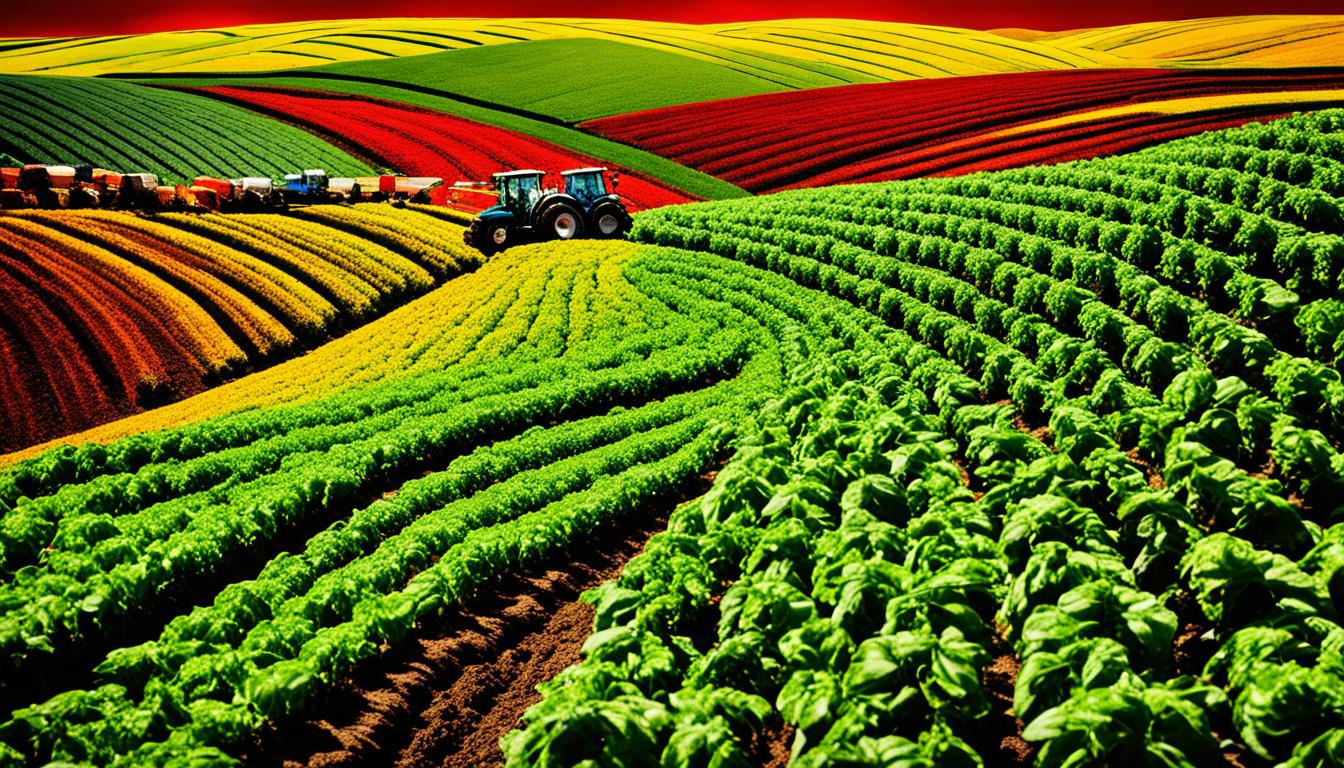
In March 2022, the national inflation rate jumped to 8.5%, the highest since 1982. This surge deeply impacted the agricultural market. Farmers face high input costs and struggle to keep their incomes steady.
In early 2022, the US inflation rate was about 7%. The International Monetary Fund forecasts a 4% rise for developed nations. These numbers show the agriculture industry is in for tough times.
Farmers are dealing with rising expenses due to weather, conflicts, and supply chain issues. It’s vital they find ways to handle uncertainties. Doing so helps keep their farms stable and profitable.
Doug Oachs is a great example. Despite price swings, he uses smart risk management and new farming tech to lessen their impact. These actions are key for many farmers to survive the current market conditions.
Farmers often face the challenge of agricultural price changes. These changes can be due to a variety of reasons. Some of the main causes include bad weather, shifts in supply and demand, and bets on future prices. This can make the market very unpredictable. It affects not only the farmers but also everyone who relies on them for food. This is especially true in places that are still growing economically.
Africa, for example, has its own story when it comes to food prices. Since 2007, the prices of basic grains have been fairly steady in local markets. But the prices in global markets have been jumping up and down a lot. Experts say that the changing climate has a big role in these up and downs. It seems it affects prices more than other known reasons like making fuel from crops or changes in oil prices.
High food prices can cause problems in countries with weak democratic rules. They can make it more likely for fighting to break out. Big money investors also affect food prices. They make bets on food’s future prices as a type of insurance. These bets can make prices change quickly. It all adds up to a very complicated system of pricing food.
“To counteract increasing and volatile food prices, long-term nutritional programs, safety nets, and sustainable agriculture are indispensable.”
There is a plan from a group of 20 big countries to deal with food price ups and downs. This plan aims to make the buying and selling of food more clear and stable. It also wants to make the rules around food betting stricter. The plan asks governments to look into how things like making fuel from crops, oil prices, and various taxes affect food prices. They also suggest setting up emergency stores of food to help keep prices more steady.
Helping small farmers deal with these uncertain prices is very important. While big price jumps are not usual, they do happen. When they do, they can hurt a lot of people and cost a lot of money. The world’s food system is very connected. It depends on good weather in some areas and can be affected by big world economic changes.
When prices go crazy, quick fixes like giving money to buyers or stopping food exports don’t work well. Experts say we need to have solid, long-term plans. These plans should make sure food can still get to people who need it. They should also keep an eye on food moving in and out of countries. Making changes to how the International Monetary Fund helps countries in trouble can also be a big help.
When times get really tough, countries should be ready to step in and help their people. They should keep extra food on hand, grow many different types of crops, and encourage people to eat a varied diet. This can help them withstand hard times with food prices.
Understanding why agricultural prices change is complex. It involves looking at a mix of global and local factors. Climate change and problems with supply chains stand out. They have a big effect on how prices change in farming and food businesses.
Climate change is a key player in making farm prices jump up and down. Researchers from Stanford and Purdue found out in 2012 that wild weather hits crop growth hard. This leads to less food and prices that swing, which is tough for farmers and shoppers.
“Food price volatility causes market hardships rather than consistently high prices,” noted Homi Kharas at the Brookings Institute, March 2011.
More studies, like those of Gilbert and Morgan in 2010, say this is not new. Yet, weird weather, linked to global warming, messes with farming habits. This means sometimes there’s too much food, other times not enough. The result? Prices can go up fast. Arezki and Brückner from the IMF suggested in 2011 that this can make poor countries less stable.
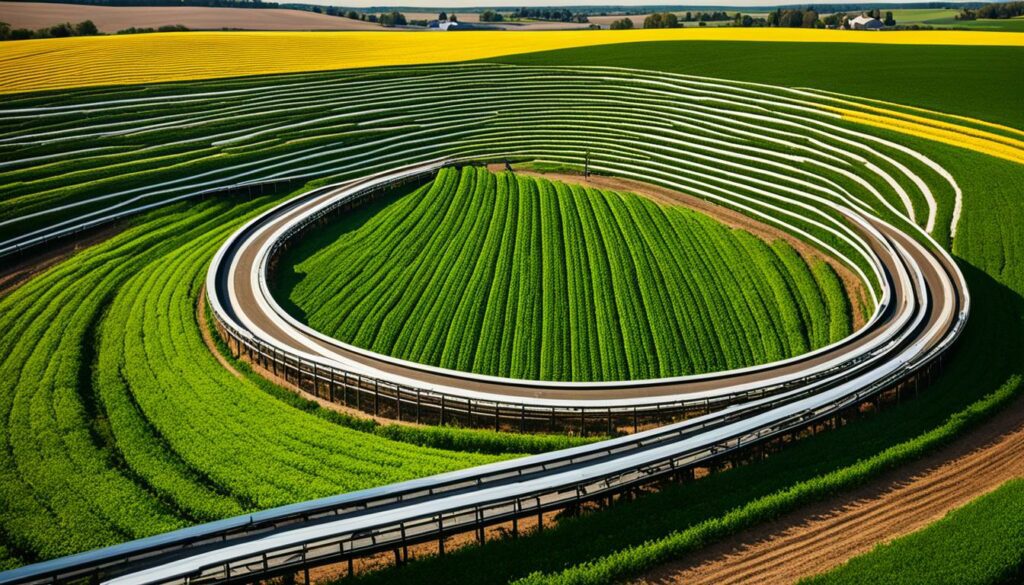
Changing ways goods move around can also shake up prices in farming. The World Bank found in 2010 that big spends on farm stuff can make prices jump. Add in problems like slow ships or expensive oil, and you get sudden, big price changes.
Roache of the IMF says food prices can jump now and then (low and high frequency). While some bumps may even out with time, others hit hard and quick. Trying to fix prices by giving money or cutting off food sales doesn’t always work in the end.
So, a mix of climate change and messy supply chains causes a lot of ups and downs in food prices. As problems in food systems grow, we need better plans to handle price changes.
| Year | Major Influence | Effect on Prices |
|---|---|---|
| 2010 | Commodities Investment | Significant Price Spikes |
| 2011 | Political Instability in Low-Income Countries | Increased Prices |
| 2012 | Climate Change (Corn) | Increased Volatility |
Farmers are finding it hard to cope with high inflation. It’s tough to keep input costs low. But, there are ways to do this and stay profitable in farming.
Farmers, like Doug Oachs, find success in fixing input prices early. This means deciding on sales targets upfront. For example, plan to sell 10% of your March corn at a set price, like $6.80. This helps keep costs steady.
Negotiating early with suppliers also avoids paying more later. It’s because inflation can make costs jump suddenly. This strategy is a smart way to manage before inflation hits too hard.
Here are the expected prices for 2022/23, as per the USDA:
| Crop | Price per Bushel |
|---|---|
| Corn | $6.80 |
| Soybeans | $14.00 |
By agreeing on these prices, farmers can plan their budgets better. This means they know what to expect in the next growing seasons.
High inflation hits farming hard. It makes the costs of running a farm go up by 7.3%. This is an extra $26.1 billion, making a total of $383.5 billion in 2021.
Problems like low river levels add to the challenge. They make it harder to move crops. A possible rail strike is another worry.
If you rent land for farming, you might see costs go up. The average price per acre jumped from $139 to $141. These hikes can affect how much money farmers make, showing the need to keep costs under control.
Tackling inflation as a farmer means careful planning. It involves making a detailed marketing plan for your crops. This plan should be ready for any disruptions and maximize profits by moving crops efficiently during good market times.
Government policies in agriculture are vital for keeping prices stable. They are needed, especially when food prices swing widely. This has been happening since 2007 because of things like bad weather, market changes, and government actions.Different countries have reacted in their own ways. They use the past and their current situation to make decisions.
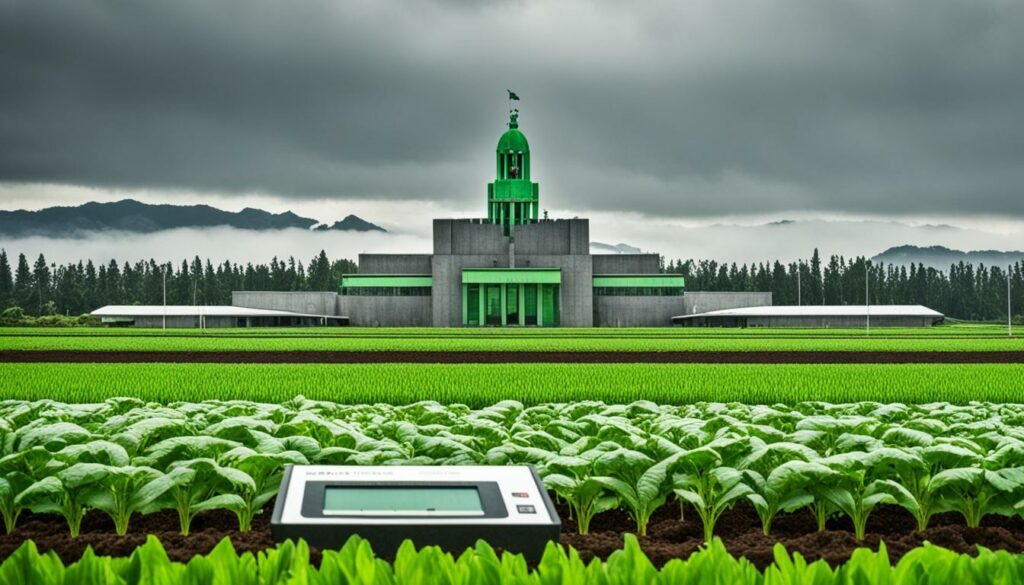
Governments help by giving out money through subsidies. They also have specific plans to support certain groups during tough times. These efforts aim to keep food prices from going up too fast.
However, these helps are not for the long term. They are costly for governments. The main focus is not on changing the agricultural sector in major ways. Instead, it’s about helping people when prices get too high.
How countries trade and the fees they charge can also make a big difference. A good trade policy can help manage food prices better. For instance, Ghana saw less fluctuation in maize and rice prices due to smart government actions.
But, sometimes setting these policies takes a lot of time. This could be because of a lack of information or disagreements within the government. These delays are not good and can lead to problems.
When making these policies, each situation should be considered carefully. The policies should be based on proven facts. Making sure that there’s enough food, using better tools to manage risks, and working together closely are all good ideas.
| Policy Recommendations | Details |
|---|---|
| Evidence-based Policy-making | Improving the evidence base for policy decisions to ensure relevance and effectiveness. |
| Appropriate Trade Policy Use | Utilising trade policies to reduce fiscal costs and enhance market stability. |
| Investment in Food Supply Elasticity | Investing in technologies and systems that increase the landscape’s flexibility to supply changes. |
| Effective Risk Management Tools | Implementing tools to manage risks related to market volatility prudently. |
| Better Management of Public Stocks | Improving the management processes of public grain stocks to avoid shortages and price spikes. |
| Biofuel Demand Management | Policies to manage price-related biofuel demand and its impact on food markets. |
| Enhanced Public-Private Collaboration | Better collaboration between government and private sectors for holistic approaches to market stability. |
Today, we see more extreme weather and global disputes than ever. But, in farming, new tech has become a light in the storm. Advanced technologies help farmers deal with unpredictable prices. They use tools like real-time monitoring and data analytics to be ahead of issues, lowering market volatility.
The 2023 ProducePay Annual Industry Survey showed 83% are worried about unstable prices. This shows why we need technology in farming so badly. Climate changes make prices hard to predict, but tech like AI and ML are making a big difference.
Software like EDI and SCM is also key. It keeps track of inventories and gives live updates. This helps stop shortages and keeps the supply chain running smoothly. ProducePay helps too, by sharing market info, which also cuts market volatility.
The USDA says dairy and fruit prices are going up. But, tech is helping farmers cope. For example, they’re using face recognition to spot cow health issues early. This helps them produce more milk and could even cut costs.
There are also apps that let you buy leftover food for less. They connect buyers with stores and restaurants. These apps fight food waste and help the environment, too.
Here’s how key technological solutions address volatility:
| Technology | Application | Impact |
|---|---|---|
| Artificial Intelligence (AI) | Real-time crop monitoring | Timely interventions, proactive management |
| Machine Learning (ML) | Yield mapping | Predictive analytics for better crop planning |
| Facial Recognition Software | Health monitoring in livestock | Reduced illness, lower food expense |
| Supply Chain Management (SCM) Tech | Inventory synchronisation | Reduced shortages, seamless logistics |
| Customised Apps | Unsold food purchasing | Waste reduction, lower carbon footprint |
Using these tech solutions, farmers can be ready for any hurdle. Technology brings a new level of stability to farming. It’s essential for fighting market changes and helping farms grow sustainably.
In today’s unpredictable field, diversifying is key for farmers wanting to steady their income and lower risks. It helps them deal with sudden changes in prices and keeps their revenues more consistent.
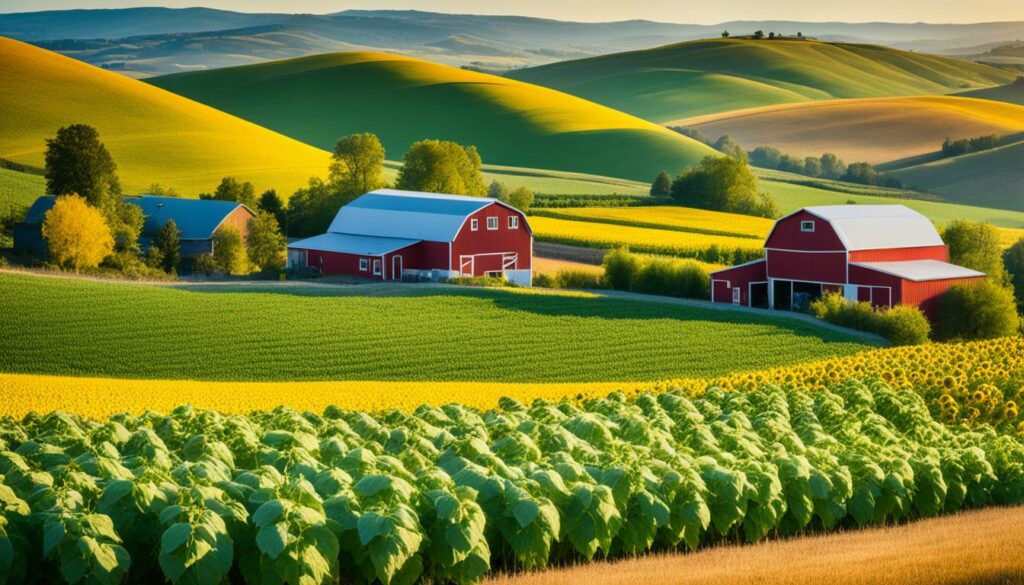
Growing different crops is a smart way to lower risks. It shields farmers from the downsides of poor harvests or falling prices. Take Poland, for instance. More than half of its 1.4 million farms have small areas for growing things. They can get a lot from growing a mix of crops. This is especially true for small farms that don’t make much money and spend a lot to run.
Deciding to grow different crops depends on many things, like the farmer’s needs or the weather. Farmers pick from a list of crops to sell what the market wants. They also try to find a good balance between how much they grow and the strength of their plants.
Keeping livestock as well as growing crops is another good way to cut risk. It makes sure that a farmer’s income isn’t only from selling crops. Europe followed this method a lot in the past. It helped keep the economy steady.
Using modern machines and having valuable farm tools is crucial for diversification. Farms that are full of the latest tech can easily handle many jobs. They not only protect against price changes but also work more effectively.
| Country | Farming Structure | Impact of Diversification |
|---|---|---|
| Poland | 1.4 million farms; over 75.2% farming less than 10 hectares | Enhanced economic efficiency and income stabilisation |
| Europe | Five types of small farms based on various factors | Reduced dependency on single crop income |
| Eastern Europe | Large state farms and numerous smallholders | Challenges in diversification due to limited economic activities |
Farming faces more challenges every day, like more competition. So, using different ways to farm well is now more important than ever. Handling both crops and animals can protect against changes and keep a farm going strong.
Looking ahead to 2024, there are several key trends to notice. One significant trend is the expected drop in energy prices by 3 percent. This will help farmers, who rely on energy for their work. Also, energy costs should drop by 4 percent in 2025, showing a steady decrease.
In 2024Q1, prices of commodities like natural gas and coal fell by 3 percent. The price of Brent crude oil might increase to US$84/bbl in 2024, coming down to US$79/bbl in 2025. This could change costs for farming machinery and transport.
Natural gas prices fell almost 40 percent in 2024Q1 but are expected to bounce back in 2025. Food prices dropped by 4 percent, whereas beverage prices, like cocoa and Robusta coffee, jumped by 22 percent.
Copper prices hit a two-year high in April, while gold prices reached new record levels. These movements show the varying fortunes of different commodities in agriculture.
The USDA changed the expected corn price to $4.70 per bushel, a 5-cent drop from earlier. Soybean prices were also cut to $12.55 per bushel due to surplus. Wheat prices declined to $7.10 per bushel because of less global demand.
Beef production is up because of more slaughters, even as the U.S. cattle herd hits lows. Pork exports are set to grow, especially to Mexico, Japan, and South Korea, with an expected 8 percent boost in 2024.
| Commodity | Forecasted Change | Comments |
|---|---|---|
| Brent Crude Oil | US$84/bbl | Marginal increase from 2023 |
| Natural Gas | -40% in 2024Q1 | Expected recovery in 2025 |
| Corn | $4.70/bushel | 5-cent decrease from previous forecast |
| Soybean | $12.55/bushel | 10-cent decrease from March estimates |
| Wheat | $7.10/bushel | 5-cent decrease due to reduced demand |
These are complex market trends for 2024. Farmers need to stay sharp and ready for change. By keeping an eye on these trends, they can stay competitive and strong in the farming business.
In the changing world of farming, partnerships are key to lowering risks and increasing stability. Working together helps farmers share resources. This makes it easier to deal with tough times in the market.
Joining forces allows farmers to know more, have a stronger voice when buying, and spend less money. Jamie Gwatkin notes that combining resources in crop growing could slash costs by £100 per hectare. In some cases, this figure is even higher. Such teamwork means less money is needed from each farmer. Plus, it can make the whole operation run better.
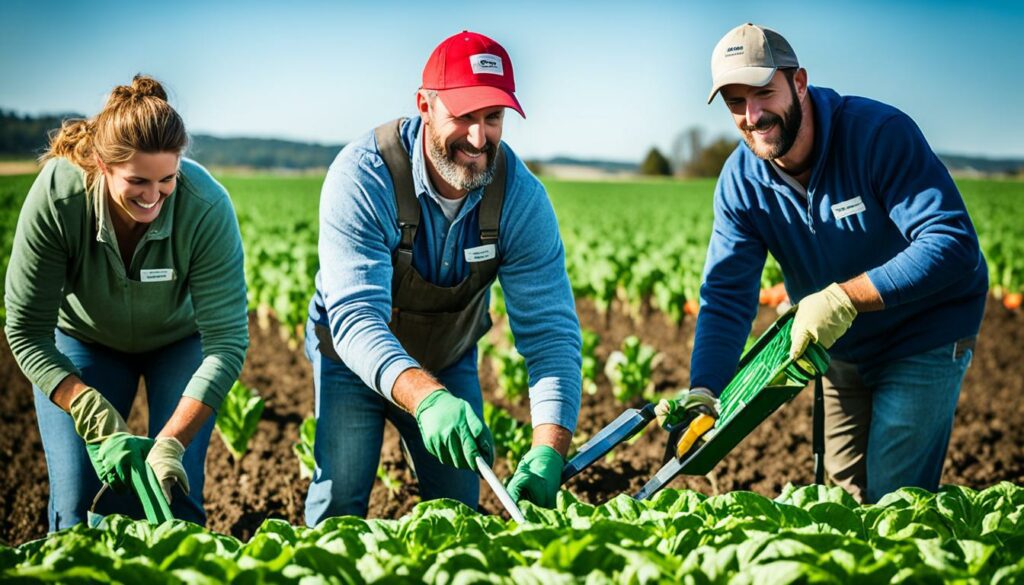
Huw Thomas and his group work together on a sheep breeding project in New Zealand. They got a 60% success rate by combining their know-how and tools. This success is a clear win for teaming up.
Marketing together helps farmers get better prices on feed, fertiliser, and fuel. Forming groups to buy these things is smart. As Mr. Jones says, it boosts power during negotiations. This usually means saving money.
Sharing big machines is another plus. Let’s take dairy farmers who share a forage wagon, for example. They save money by not owning the machine themselves. And it makes their work more flexible and resilient.
Comparing how well you’re doing against others is also helpful. It encourages everyone to do better and smarter. Such teamwork turns farming into a learning journey towards bigger wins.
Teaming up can also affect prices throughout the supply chain. When everyone from start to finish agrees on costs, it helps keep things stable. This way, when the market goes up and down, everyone’s in it together.
Securing financial resilience in farming is key. This is especially true now, with weather surprises and other problems. Agricultural insurance helps farmers deal with these ups and downs. It keeps the market steady and supports growth in the sector.
It’s important for farmers to know about the various insurance types. These cover different risks. Here are the main types:
When choosing insurance, farmers must think carefully about their situation. This includes:
| Factor | Explanation |
|---|---|
| Risk Exposure | Look at how much risk you face from the weather, pests, and market changes. |
| Credit Accessibility | See how insurance might help you get more credit. For example, in India, more insurance meant more credit for farmers. |
| Government Subsidies | Think about if there are any subsidies to help with insurance costs. This can make it cheaper and more useful. |
| Regional Specificity | Understand that how well insurance works can differ from place to place, like in China’s rural areas. |
In Kenya, over 500,000 farmers are already using tailored insurance. This shows how important the right insurance is. Choosing carefully can improve financial safety and protect against unknown risks.
Consumers are now preferring organic and sustainable products more than before. This new trend is making a big change in how much we pay for farming products. Farmers and others working in agriculture are finding ways to make their products more sustainable. This change is because people want options that are better for the planet.
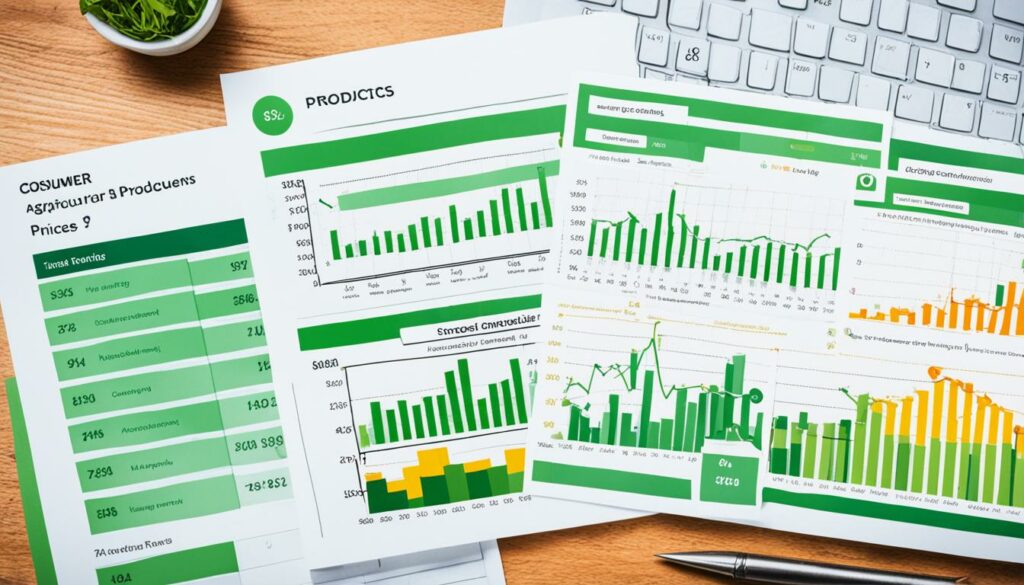
Today, many people are looking for and choosing organic and sustainable items. Between 2006 and 2008, food prices went up a lot. This was partly due to a financial crisis. Since then, more and more people are choosing sustainable options. According to the ProducePay Annual Industry Survey, 83% said that the varying prices are a major problem. This shows a deep consumer impact on agricultural prices.
From 1990 to 2009, various food prices went up and down. Some commodities became less expensive over the years, like cocoa and sugar. Despite more people wanting sustainable choices, the prices of these items still change a lot. This is a big issue in the industry.
Farmers and others in agriculture are changing how they make their products. They are using different crops and new technologies. These changes help keep the prices stable. For example, soya bean oil prices became more volatile over time. In contrast, banana prices saw less change. This shows that prices vary across different products in farming.
Now, producers are doing more sustainable farming to meet the new demands. They use technology to watch over crops and forecast future needs. This helps them make decisions before any big problems arise. This way of farming helps keep the market stable.
| Commodity | Volatility Trends (Last Two Decades) | Consumer Demand Impact |
|---|---|---|
| Rice | Significant rises in volatility | High |
| Cocoa | Fell significantly | Moderate |
| Soya Beans | Decreased | High |
| Vegetable Oils | Reduced | High |
| Bananas | Decreased | Low |
| Fish Products | Fell significantly | Moderate |
There is a growing demand for sustainable farming goods. This means producers must change how they work. By choosing sustainable and organic ways, the worry about prices changing too much can lessen. This also builds a better, more sustainable way for food to get from farms to people’s tables. It is good for both the producers and the planet.
It’s vital to have strong supply chains in agriculture to tackle market changes. By 2021, one in three people worked in agriculture worldwide. So, resilient supply chains are important for jobs and keeping things stable.
One key way to make supply chains stronger is to have many suppliers. This keeps risks low, especially in places like Ghana. There, varied supply chains help cocoa farmers get what they need to live decently.
Technological breakthroughs are key in making supply chains better. They help keep an eye on where things are and make quick adjustments. This means farmers can get what they need right away, even if there’s a hiccup.
“Sustainable sourcing strategies need to improve women’s access to agricultural inputs, capital, technology, and markets,” underscores the Farmer Income Lab.
It also helps to give farmers all the help they need, like financial aid. These support packages really boost how much money they make. They are especially important for women working in farming in poorer nations.
Another smart move is setting minimum prices for farm goods. This means farmers can always cover their costs and make some profit. It keeps things steady when markets are up and down.
| Strategies | Benefits |
|---|---|
| Diversifying Supplier Bases | Reduces reliance on single sources; mitigates risks associated with disruptions. |
| Expanding Localised Distribution | Protects farmers from supply chain disruptions; ensures timely access to inputs. |
| Guaranteed Minimum Prices | Stabilises farm gate prices; covers production costs plus a premium. |
| Holistic Service Packages | Combines financial support; significantly increases farmer incomes. |
| Sustainable Sourcing Strategies | Improves access for women; reduces community vulnerability. |
By using these tactics, we can make the agriculture sector stronger. It helps us prepare for whatever lies ahead.
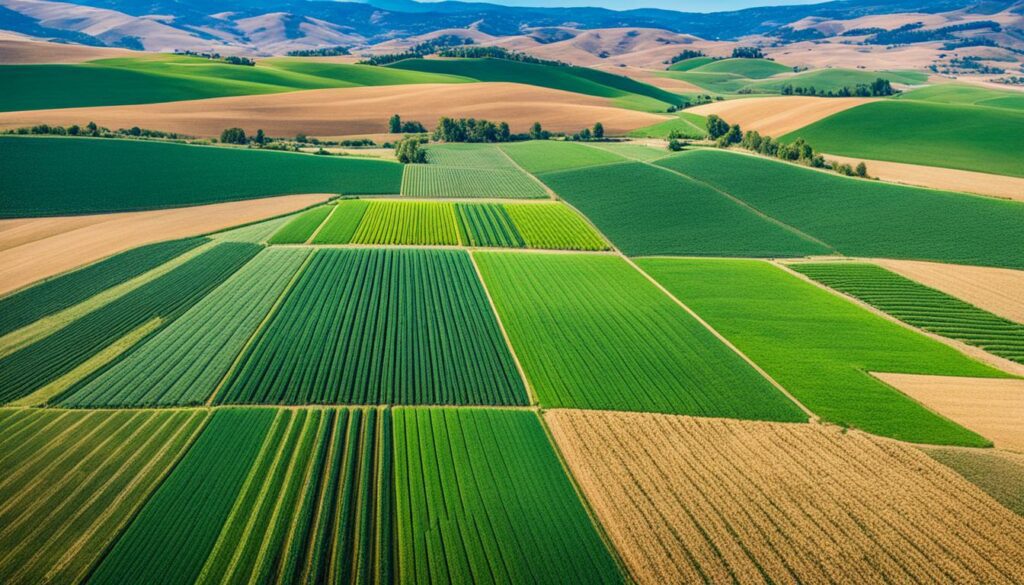
Farming faces big challenges, especially with the prices of key food items going up and down. Some farmers have shown great skill in handling these uncertain times. They use many different methods to stay stable. Doug Oachs is a prime example of this success.
Doug Oachs is recognised for his smart farming strategies in unpredictable times. Prices of major crops shot up from late 2006 to mid-2008, then dropped quickly due to a global financial crisis. But Oachs was ahead of the game. He tracked prices for grains and oilseeds month by month, turning risks into wins.
Looking at global data from 1970 to 2009, some food items like rice and bananas became more volatile over time. Meanwhile, others, including cocoa and soya beans, showed less fluctuation. Oachs used a method called GARCH modelling to predict market changes. This helped him plan better.
| Commodity | Volatility Trend (1970-2009) |
|---|---|
| Grains | Low |
| Meats | Low |
| Fresh Fruits | High |
| Rice | Significant Rise |
| Bananas | Significant Rise |
| Cocoa | Significant Fall |
| Soya Beans | Significant Fall |
| Sugar | Significant Fall |
| Certain Oils | Significant Fall |
Between 2007 and 2009, food prices’ volatility changed. Oachs’ strategies highlight how a custom plan can beat farming challenges. He focused on grains, fresh fruits, and other vital goods, showing how to use market insights and predictions. This proved that being smart is key to handling rough times.
Doug Oachs and farmers like him teach us that being proactive is very important. Their stories offer a guide for surviving market ups and downs. They show that using good information and planning can turn risks into chances.
Price changes in farming can be hard to deal with, but there are ways to make it easier for farmers. We talked about how things like climate change, problems in the supply chain, and inflation can make prices go up and down. Experts like Christopher Gilbert and C. Wyn Morgan, and Nicholas Minot have shown us that these ups and downs are part of farming. Things usually even out over time.
Government actions are key to keeping prices steady. They do this by offering money, help programmes, and setting rules for trade. Important groups like the FAO, World Bank, and the International Fund for Agricultural Development say these steps help both local and global markets. The G20 has a plan from June 2011 that aims to make markets more efficient and clear, showing that many steps together are best to handle farming’s problems.
New technologies and ways to grow different crops can also protect farmers from losing money. For example, using smart data and watching the crops closely help farmers to choose better. Growing different plants and keeping animals can also help against market ups and downs. Farm insurance and teaming up with other farmers add even more protection, making the business more stable.
In the end, managing farming’s price changes is hard but not impossible. By using smart policies, new technologies, and working together, farmers can do well. They can reduce the risks from the market’s changes and stay in business for a long time. This shows that a mix of new ideas, help from the government, and working together can help farmers a lot.
Price volatility in farming means that prices of farm goods often change and are hard to predict. This happens due to climate change, delays in supply, and shifts in what people want to buy.
They can deal with higher costs by locking in prices early, looking for deals on bulk buying, and finding new suppliers. Also, using tech to manage their resources better can soften the blow of inflation on farming costs.
Government rules and help, like giving subsidies or regulating trade, can keep prices from rising too fast. They support farmers and keep costs down, which helps keep food affordable.
Tools like smart crop tracking, data analysis, and models that predict prices can make a big difference. They give farmers a way to make smart choices and lower the risks they face.
Having more than one crop or animal type spreads out a farmer’s risk. It means they won’t be hit as hard if the price of one product suddenly falls. It makes farming a bit safer and more stable.
In 2024, people will probably want more organic and eco-friendly foods. We’ll see farm tech getting better and maybe some new laws that will change the farm market. Keeping up with these trends will be key for success.
Working together, like through shared marketing or joining forces with other farmers, lets them share costs and know-how. These partnerships offer more strength and can help deal with the ups and downs of the market.
Farmers can get various insurance types, like for crops, animals, or to protect their income. It’s important to pick right to get cover for possible financial hits from changing market prices.
As people want more organic and green products, these items may sell for higher prices. Farmers who adapt their methods can find new, profitable markets. This shift can also help keep their earnings steady.
Making supply chains tough involves working with many suppliers, using tech for clear tracks, and having backup plans. These steps ensure farms can stay running even when there are bumps in the market or supply chain.
Take Doug Oachs, who managed through price changes with crop variety, new technology, and working closely with others. Studying such success stories can teach others how to handle tough situations.